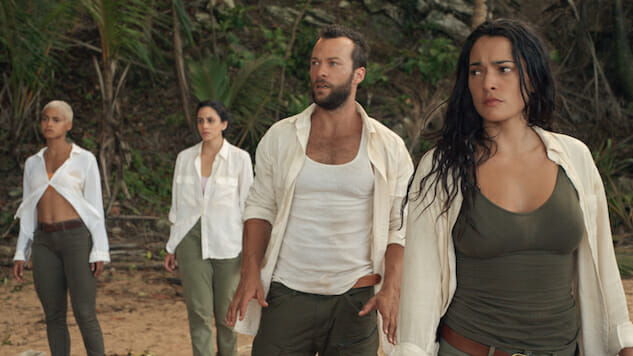Netflix’s The I-Land May Be the Worst TV Show I’ve Ever Seen
Breathtaking.
Photo Courtesy of Netflix
I’ve always wondered at what point the cast and crew of a TV show know it’s a total disaster. When do you mentally throw in the towel and just collect the paycheck, hoping that you can unlink the series from your IMDB account? These questions were at the forefront of my mind while watching seven horrendously ill-conceived episodes of Netflix’s The I-Land, a show that wouldn’t have lasted more than one episode in a traditional broadcast model, but thanks to binge culture and the ability to hide new content, was incredibly allowed to be made and released.
From the start, The I-Land looks like a ripoff of better series. Ten strangers wake up on an island in weirdly similar clothing and a few props, not sure how they got there or even who they are. But since they’re all young and beautiful, their first instinct is not to search for food or water but to strip off and go swimming, where one of them is immediately eaten by a shark. The point of the island is something tied to redemption, and the question of whether people can work together to find a way off or just resort to going full Lord of the Flies. Lost, of course, did this first and indescribably better, but there are also shades of Westworld, Minority Report, Survivor, and The Hunger Games. In many ways, it’s like that meme of “I made a computer watch these things and this is what it thinks a script is.”
However improbably, the series was created not by a computer, but by Anthony Salter and written/showrun by Neil LaBute. It’s also an example of a series where absolutely nothing connects, so it’s hard to tell where things went the most wrong (the acting? writing? directing?) But with lines like “there was never supposed to be a cannibal!” or “ain’t it cool we don’t even need birth control in here?” or the piece de resistance, “there’s no rape here, just sex or no sex,” one cannot help but give a hard look to Mssr. LaBute.
The series has a few recognizable names in its lead roles, including Kate Bosworth, Alex Pettyfer, and Natalie Martinez (whose character Chase is something of a protagonist), but all of them are acting in totally different shows, sometimes within the same scene. All of the characters are hostile, but what choice do you have when you’re being told things like “when you remember who you are, you’re gonna want to kill yourselves! Hehe!” In what feels like a fourth wall-breaking moment, another character later announces, “this is probably a fucking shitshow in your head right now, how could it not be?” He’s not wrong.
I’m going to get into spoilers here, so if for some reason you want to go into this show without knowing anything, turn back now. But I can safely say that knowing more about it will neither help nor hinder your experience. It simply is.
The I-Land is built as a Mystery Box TV series, where you have amnesiacs gathered in a weird, hostile place that seems rigged. That’s something they start to understand pretty quickly, but after a few very random clues in the first two episodes, the show just gives up and explains everything to viewers in the third.
So yes, this is a simulation, and Chase wakes up from it somehow. But no worries, as the doctors, nurses, academics, and even the warden of the jail where this is all happening just decide to sit her down and have an episode-long session of exposition about it. None of it connects, including why Chase is in a totally separate room from her island counterparts who are suspended in goo (she is never in the goo, but she is held down by “magnets”). The answers to details like these are lost, which is a shame because the show makes sure that everything else it wants you to know is spelled it out in incredibly blunt terms, killing all possible mystery. Nothing adds up, though. The more we’re told, the more questions are raised. But not good, mystery-building questions. Questions like, as I wrote in my notes, “is this show a spoof (??)”
-

-

-

-

-

-

-

-

-

-

-

-

-

-

-

-

-

-

-

-

-

-

-

-

-

-

-

-

-

-

-

-

-

-

-

-

-

-

-

-








































